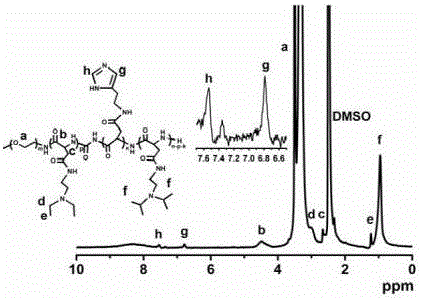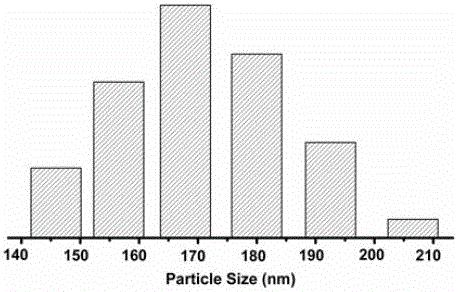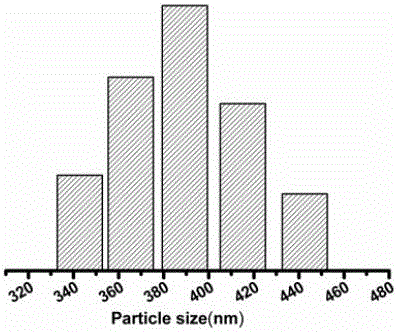PH and temperature sensitive nano-vesicles and preparing method and application thereof
A dual-sensitivity, nano-vesicle technology, applied in the fields of polymer chemistry and biomedical engineering, to achieve the effect of increasing deep tissue penetration and excellent chain flexibility
- Summary
- Abstract
- Description
- Claims
- Application Information
AI Technical Summary
Problems solved by technology
Method used
Image
Examples
Embodiment 1
[0044] Example 1 Polymer PEG-PAsp (DEA- co -His- co -DIP) preparation
[0045] 1, β -The synthesis of benzyl aspartate, reaction mechanism and reaction process are as follows:
[0046]
[0047] First prepare a one-necked flask (500 mL), add 100 mL of anhydrous diethyl ether, then slowly add 10 mL of concentrated H 2 SO 4 (98%), stirring vigorously while adding dropwise, after cooling to room temperature, add 100 mL benzyl alcohol, after fully stirring, use a rotary evaporator to rotary evaporate ether. Then add a total of 13.3 g of aspartic acid into the reaction flask in 3 times. The reaction was uniformly stirred at room temperature for 24 h, then 200 mL of 95% ethanol was added, and 50 mL of pyridine was added dropwise with a dropping funnel, and vigorously stirred while dropping. Then refrigerated overnight, pumped the filtered solid, stirred and dissolved at 80°C, filtered hot, and refrigerated the filtrate overnight. Filter, recrystallize 2 times according t...
Embodiment 2
[0061] Example 2 Drug-loaded nanovesicles mPEG-PAsp (DEA- co -His- co -DIP) preparation
[0062] A nanovesicle loaded with hydrophilic antitumor drugs is prepared by the following method: take the polymer mPEG-PAsp (DEA-PAsp) prepared in Example 1 CO -His- CO -DIP) 20 mg, with 2 mL of anhydrous CHCl 3 After dissolving, 0.2 mL of water dissolved with doxorubicin was added dropwise into chloroform by ultrasound in an ice-bath environment to form the first emulsion. Then, the first emulsion was added dropwise to 10 mL of PBS (pH 7.4, 0.05 mol / L) under the same conditions, and the second emulsion was formed after ultrasonication for 5 minutes. Chloroform was then removed by rotary evaporation, followed by dialysis against pH 7.4 PBS using a 14 KDa dialysis bag to remove uncoated doxorubicin. The final vesicle solution was filtered with a 450 nm filter to obtain doxorubicin-loaded nanovesicles (referred to as DOX-PPEHD vesicles).
[0063] A nanovesicle loaded with an ul...
Embodiment 3
[0072] Example 3 Drug-loaded nanovesicles mPEG-PAsp (DEA- co -His- co -DIP) thermogravimetric analysis
[0073] After the PFP / DOX-PPEHD vesicles were treated, the thermal weight loss of the vesicles was detected by the thermal analysis system Pyrisis-1 (PerkineElmer, USA). We used TGA to measure the thermal stability of PFP / DOX-PPEHD vesicles, and we selected DOX-PPEHD vesicles without PFP as the control group. Such as Figure 6 As shown, PFP / DOX-PPEHD vesicles experienced the first weight loss between 40 °C and 80 °C, while DOX-PPEHD vesicles did not experience this weight loss at this temperature range, the reason for this weight loss It is the PFP contained in the PFP / DOX-PPEHD vesicles that reaches the boiling point in this temperature range and turns into a gas, and the vesicles are gradually burst and released. From the weight loss rate, we can calculate that the load rate of PFP is 3.24%. In the figure, we found that both PFP / DOX-PPEHD vesicles and DOX-PPEHD vesi...
PUM
| Property | Measurement | Unit |
|---|---|---|
| Particle size | aaaaa | aaaaa |
| The average particle size | aaaaa | aaaaa |
Abstract
Description
Claims
Application Information
 Login to View More
Login to View More - R&D
- Intellectual Property
- Life Sciences
- Materials
- Tech Scout
- Unparalleled Data Quality
- Higher Quality Content
- 60% Fewer Hallucinations
Browse by: Latest US Patents, China's latest patents, Technical Efficacy Thesaurus, Application Domain, Technology Topic, Popular Technical Reports.
© 2025 PatSnap. All rights reserved.Legal|Privacy policy|Modern Slavery Act Transparency Statement|Sitemap|About US| Contact US: help@patsnap.com



